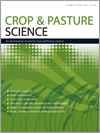Mungbean is a staple food crop throughout Asia and a valuable export crop for Australia worth over AU$100 million each year. Halo blight is a bacterial, seed-borne disease of mungbean causing significant yield loss and instability within the crop. This review synthesises past and current research and assesses emerging technologies to develop improved strategies for management of halo blight in mungbean.
CP18541 Abstract | CP18541 Full Text | CP18541PDF (885 KB) Open Access Article





